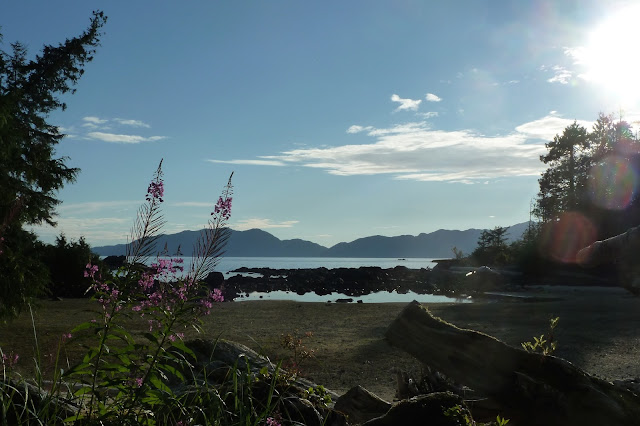Heading south from Ocean Falls through Lama passage on August 9th, we were surprised to see the Disney Wonder’s icon appear on the chart plotter. We’ve seen the Disney Wonder in Alaska. She is a big ship. Alaska has big waters. Greywolf is a small ship. Lama Passage is small water.
Greywolf made the turn into the bigger waters of Fisher Channel before
the handsome ship passed us.
She has Mouseketer ears on her stacks. It made us smile just to look at her.
It was obvious there was a “fish opening” the next day. Seine boats were streaming north all day as we headed south toward Fury Cove where we would spend the night.
Underway equipment change-out. We are part of the cruising community that engages in the on-going “swivel-on-the-anchor-chain”/“no-swivel-on-the-anchor-chain” discussion. Doug is taking the swivel off the chain to see if that works better. Anchor retrieval problems have been a topic of concern that we have spared you from because we didn’t want you to worry.
Addenbrook Island light station--one of the few reference points on the marine weather forecast for this part of the coast. Environment Canada apparently doesn’t see much point in providing wind/sea-state information for the “inside waters”.
We’ve never experienced weather in Fury Cove demonstrating how it earned its name. It could have been renamed “Idyllic Cove” on the this day. One advantage to anchoring here, in addition to being fairly close to Cape Caution, is that you can look out onto Fitzhugh Sound and south toward Queen Charlotte Sound, to see what is happening.
When we took Dinghy ashore, dozens of sand pipers were busily dining in a small lagoon, blissfully unaware of A Poodle about to launch herself off Dinghy. Allie chased and splashed. Sandpipers took off. Allie took off. Sandpipers returned. Allie returned. Allie chased and splashed. Sandpipers took off. Each time, fewer returned.
Stalking.
Chasing was not working and the objects of the game were diminishing at an alarming rate.
Time to change tactics.
Time to change tactics.
Soon there were no more returning birds. But, who cares! We’ve got
Dogzz to share the beach with. (No, that is not Doug and that is not Dinghy although it is the same brand and probably same outboard. That was a frequent occurance.)
The size of the driftwood tells you how Fury Cove got its name.
All the white shell beaches on the coast, and there are many of them, are “kitchen middens” created by the First Nations people before Europeans came upon the scene. Seafood shells piled up over hundreds of years indicating places where the people had their summer camps or permanent settlements.
Doug and I are tend to be minimalists, but we have occasionally fallen for “cruising enhancements”——gadgets that are advertised to make life easier.
Last year’s enhancement was an Easy Moore designed to make it easier to get a line through a mooring buoy ring from a high bow. It has a device on the end of a boat hook pole that somehow threads the line through the ring on the buoy. It worked. Three times. We were thrilled. And then, at Montague Harbor, something Went Terribly Wrong. Doug had to remove the boat hook from the device with pliers and use our three foot long wire cutters to the device off the buoy ring.
Not as advertised....
This year’s Gotcha! was the Anchor Buddy. It prevents you from having your dinghy left high and dry on an outgoing tide. Or so we thought. The Anchor Buddy consists of a length of bungie cord with a clip on either end. Cost: 10% of a Boat Unit. Purchase a small mushroom anchor to clip to one end of the line. Cost: 2.5% of a Boat Unit. This assumes you already have one anchor for the dinghy. Otherwise, buy two. Purchase an extra long line for the bow. We opted to buy a new dinghy tow line that we needed anyway: Cost 12.5% of a boat unit.
Did you add all that up? We didn’t. But it’s worth it to make sure the dingy is not left high and dry on an outgoing tide, right?
The theory is: when you are about 50 feet from the beach, you drop the scrunchy Anchor Buddy line with one anchor attached. Other end of the line is clipped to the stern of the dinghy. Proceed to the beach. Take the bow line and the other anchor ashore, leaving plenty of loose line. Dinghy will be pulled back by the scrunched line to hover in deep water over the anchor you dropped 50 feet from shore, safe from the outgoing tide. When you return, Dinghy will be floating freely in deep water. Pull on the shore line, bringing the dinghy to you, embark, and return to the Mother Ship.
We decided to try out the Anchor Buoy in Fury Cove.
Waiting for the tide to come in is similar to watching paint dry.
We sat on the shore and tried to will the tide to come in far enough
to float our boat, that was resting comfortably in a few inches of water.
Obviously, there is a learning curve. We think it has to with the beach gradient. Fury Cove’s beach is very shallow. Anchor Buddy is not a write-off. Yet.
With lovely scenery and weather, we couldn’t complain about being “stranded".
We shared Fury Cove with about a dozen other boats,
representing the Inside Passage cruising community
With a good wind and “sea state” forecast for Queen Charlotte Sound,
(West Sea Otter buoy: 1.2 meters) Greywolf departed at first light on
August 11th to round Cape Caution.
Destination: Port Hardy






















